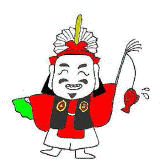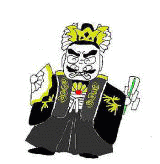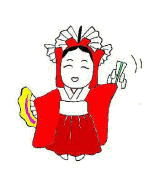English ・ 日本語 ・韓国語 ・ French
I comment on Biccyu Kagura for a visitor from a foreign country.
外国からのお客様向けに備中神楽を解説します。
I comment on Biccyu Kagura for a visitor from a foreign country.
外国からのお客様向けに備中神楽を解説します。
Bichu Kagura commentary pamphlet
★備中神楽解説パンフレット★
Bichu Kagura commentary
| 1 | Summary 概要 | ||
| 備中神楽(Biccyu Kagura) 備中神楽は、岡山県の備中地区の農村で演じられる神楽である。 "Biccyu Kagura" is a noh dance played in a farm village of Biccyu district of Okayama. 備中神楽は原始的な信仰である。 "Biccyu Kagura" is primitive faith. 嵐または病気などを引き起こす神(荒神)の心を鎮める為の行事として荒神祭りがある。備中神楽は、鎮魂行事として、そこで演じられます。 There is Koujin Festival as an event to quiet a heart of God (Koujin) causing a storm or a disease. Bicchu noh dance is held as a requiem event there. 「備中神楽」は、民俗芸能として伝承されています。長い年月の間に、「神の信仰心」が「芸能」と融合したのです。現在、「備中神楽」は、秋祭りなどに欠かせない郷土芸能となっています。 "Biccyu Kagura" was handed down as a folk entertainment. During the long time, "Their faith in God" was combined with "an entertainment". Now "Biccyu Kagura" is the folk art which is indispensable to autumn festivals. 備中神楽には、神代神楽三曲がある。 "Biccyu Kagura" includes three programs called "Jindai Kagura". 今から200年前ごろ。西林国橋が、日本誕生に関する神話の歴史書(古事記と日本書紀)から三話を選び、そして、劇化した。「天の岩戸開き」「国ゆずり」「大蛇退冶」の三話である。それは、バラエティーに富んだ芸能性の高い神楽になりました。それが、「神代神楽」です。彼は、岡山県成羽の出身で国学者であり、神官であった。 About 200 years ago, Kokkyou Nisibayasi chose 3 episodes from the mythical history books about the birth of Japan (Kojiki and Nihonsyoki). He dramatized them afterwards. It is Composed of 3 episodes, "Amano iwato biraki" (Opening the Gate of Celestial Rock) "Kuniyuzuri" (Transfer of a country) "Orotitaiji" (big snake extermination). The drama became a high level of noh dance with variety of entertaiment. That is "Jindai Kagura". Kokkyou Nisibayasi was born in Nariwa Okayama. He was a scholar of ancient Japanese thought and culture, and was also Shinto priesthood. 備中神楽は、岡山県重要無形民俗文化財の第2号に指定される。(1956年) Biccyuu Kagura is appointed to "an important intagible cultural asset. No. 2 by Okayama prefecture. in 1956. そして、備中神楽は、「国の重要無形民俗文化財」に指定される。(1979年2月) And in February,1979. It was appointed by the nation. |
|||
| 2 | Guidance dance 導き舞い | ||
| 導き舞は「猿田彦の命」の由来を説明する舞である。その舞は、「備中神楽」の基本となる舞い方が披露されています。 Guidance dance is one to explain an origin of "Sarudahiko no mikoto". Basics of the dance of Biccyuu Kagura. この神は、天孫瓊瓊杵尊が芦原中津國に天下る途中、天の分岐点で出迎え、神々を先導した神で、日本書紀によると、鼻が長く、目が赤くホオズキのように輝いているという。 This is the God who led a party of Gods at the crossroad when Gods are in the middle of falling on ground. The God is written in Nihonsyoki as follows. A nose is long and eyes are red and shine like a ground cherry. |
|||
| 3 | Dancing of "Sarudahiko no mikoto" 猿田彦の命の舞 | ||
| この舞は、神楽の始めにおこなわれる。この神は、「先祓い」の神と呼ばれている。 This dance is done at the beginning of Kagura. This God is called God of "Saki barai"which means to remove dirt of the road, Stepping ahead. その舞には、日本刀や槍を東北南北に向けて切り裂くような動作を観ることができる。 Sarudahiko uses a Japanese sword or a spear to every direction and cuts the air and tears the air in the dance (Mai) |
|||
 |
|||
| 切り裂くことによって、不幸や災害を除くなどの意味を持っている。 The Mai has a meaning to remove misfortune and a disaster. これから始まる神楽の先陣として、世話役、神楽師や舞台を清める。 As the van of beginning Kagura, Sarudahiko cleanse the staff and the performers and the stage. 更に、お客様も清める意味をもっている。 Furthermore, Sarudahiko cleanses the audiences. この神の容姿は、次の通りである。赤地に金銀を配した鎧を着けている。顔は、鼻の高い面をかぶっている。そして、白い頭髪をかぶっている。下半身には、袴を着けている。そして、腰に刀をさしている。両手に扇子をもっている。 A figure of this God is as follows. He puts on a red armor with a design of gold and silver on the red groundwork. This God puts an a high-bridged nose mask on the face. And he is covered with white hair. He puts on a hakama to a lower part of the body. And he places a sword in a waist. And he holds a folding fan in both hands. |
|||
| 4 | Open the Gate of Celestial Rock 天の岩戸開き | ||
| 天照大御神が弟神、素戔鳴の尊の悪行に怒り、天の岩戸に隠れ、天地が暗闇になってしまう。 The Sun-Goddess was angry at evildoing of younger brother God "Susano no mikoto".She was covered to Gate of Celestial Rock(the Iwato). And the nature becomes darkness. 彼女が岩戸に隠れてしまった為、あわてた諸神が「天の安河原」に集まり、一計を案じているところからこの物語ははじまる。 Various Gods, thinking out aplan, gather in the place called "Ama no yasugawara". This story begins from that scene, because she has been hidden behind the Iwato. |
|||
| 「天児屋根の命」と「天太玉の命」の両神と、この二柱に呼び寄せられて翁の面の「思兼の命」が現れる。この神は思慮深い知徳の神で天照大御神を岩戸から出す手段を思案する。 "Amenokyane no mikoto" and "Ameno futodama no mikoto" appear. "Omoigane no mikoto" of an mask of an old man summoned by two people appears afterwards. This is the God of knowledge and virtue of good sense. He comes up with an idea to let the Sun-Goddess go out from the Iwato. |
|||
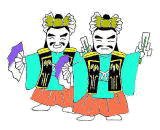 |
|||
| 次は天鈿女の命。早い調子の太鼓に合わせて大きな動きで舞い踊る。手には扇子と鈴を持ち、サンヤー サンヤーの囃子で軽やかに舞う。 "Amenouzume no mikoto" appears in next. I dance by big movement to a drum of early condition, and she dances it. She holds a folding fan and a bell in a hand. She dances to a shout of "sanya sanya" lightly. |
|||
| 続いて剛力の神の手力男の命が登場、岩戸に見立てた大幕を引き開けると、天照大御神が鏡を持ち鎮座している。天鈿女の命が大御神の鏡をとり、幕を閉じる。 "Tatikarao no mikoto" of God of great physical strength appears next. He pulls out the large curtain to show the Iwato. Then the Sun-Goddess with a mirror is sitting down. "Amenouzume no mikoto" takes the mirror of the Sun-Goddess then. The Iwato faller. 最後にうれしき舞を舞い幕となる。 Various gods dance happily and the curtain is fallen. |
|||
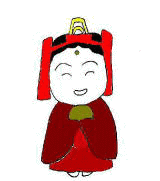 |
|||
| 5 | Abdication 国譲り | ||
| 高天原より経津主の命・武甕槌の命の両神が、出雲国を治める大國主の命のもとに現れる。 Gods of "Futunusi no mikoto" and "Takemikaduti no mikoto" appear to "Ookuninusi no mikoto", the King who governs the Izumo Country. 両神は天照大神の勅使として、國を譲るよう勧告にやってきたのだ。大國主と両神の交渉は決裂するが、稲脊脛の命が現れこれを仲裁する。 Both God came over for an advice to hand over a country as an Imperial envoy of the Sun-Goddess. The negotiations of Ookuninusi no mikoto and the both of Gods break down, but "Inasehagi no mikoto" appears and arbitrates this. |
|||
|
|||
| 談判の結果、國を譲るか否かの判断は、大國主息子の事代主の命に委ねられることに。事代主の命は「皇孫に國を献上すべし」と進言するが、もう一人の息子の建御名方の命は憤慨。単身、両神へ闘いを挑む。 As a result of the negotiation, a decision of handing over the country is entrusted to "Kotosironusi no mikoto", a son of "Ookuninusi no mikoto." "Kotosironusi no mikoto" makes a proposal to "give aristocratic posterity the country", but "Takeminakata no mikoto", the other son feels indignant. "Takeminakata no mikoto" challenges to fight with both of Gods. |
|||
|
|||
| 乱戦の末、二対一の負い目もあり建御名方の命もついに力つきて降参する。そして、両神がうれしき舞をおさめ幕となる。 After a confused fight, "Takeminanokata no mikoto" surrenders because his power is less compaired with the power of the two gods. |
|||
 |
|||
| 6 | Large snake extermination 大蛇退治 | ||
| 悪行をはたらいたいたため高天原を追いやられた素戔鳴の尊が、櫛稲田姫を救うため、八俣の大蛇を退治するという物語。素戔鳴の尊は、櫛稲田姫を私にくれるなら大蛇は義姉の仇となる。そのため謀をもって大蛇を退治すると約束する。その謀とは、毒酒を八千石造り大蛇に飲ませ、酔って眠ったところを切り倒すというものであった。 It is a story that "Susano no mikoto" who was expelled from "Takamagahara (Japanese Olympus)"of his wicked exterminates the large snake to save "Kusiinada hime". As for "Susano no mikoto", the large snake is an enemy of a sister-in-law, He says "if you give Kusiinada hime to me, I promise to exterminate the large snake. The plan is next. I'm going to make much poisoned alcohol and serve it to the large snake. And I cut it down when the large snake gets drunk and sleeps." |
|||
|
|||
| 後半最初の演目は、酒作りの守護神、松尾明神の舞です。この神はおどけた道化面を着けています。そして、彼は、おどけた身振りで出てきます。彼は、太鼓演奏者と滑稽な対話をしながら演じます。 The latter half first program contains of a dance performed by "Matunoo myoujin", the God of Sake making.. This God puts on clown mask and is funny. And he comes out by the funny gestures. He performes, doing funny talks with a drum player. そしてクライマックスは、素戔鳴の尊と、神殿狭しと暴れる大蛇による決戦が始まる。 And the climax is a decisive battle of "the large snake which went on the rampage on the stage" vs. "Susano no mikoto". 素戔鳴の尊が大蛇の首を切り落として、大蛇は、退治された。 "Susano no mikoto" cuts off a neck of the large snake.The large snake was exterminated. 更に、大蛇の体内から宝剣を見つけ、それを天照大神に献上することになる。そして、大蛇退治が幕となる。 Furthermore, he finds a Sword from the body of a large snake, and he is to give to the Sun-Goddess it. And large snake extermination is over. |
|||
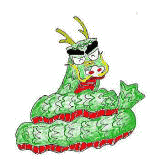 |
|||
| 7 | Kibitu 吉備津 | ||
| それは、吉備津彦の命が温羅(吉備冠者)を退治する物語です。温羅(吉備冠者)は、備中国で暴れる鬼であった。最初に、彼は、備中国の主、岩山明神の姫から二本の矢を渡されます。 It is the story that "Kibituhiko no mikoto" exterminates "Ura". "Ura" was the ogre who acted violently in a Biccyu country. It is handed two arrows to him first by a princess of "Iwayama myoujin" of a master of a Biccyuu country. 姫が矢を手渡した後に、吉備津彦の命は、戦いにそなえて力のこもった荒々しい舞を舞う。 "Kibituhiko no mikoto" dances violently that was full of power for a fight after the princess handed it an arrow. |
|||
| 突然、大幕が開き、鬼の面に黒の頭髪をかぶった温羅が出てくる。 A large curtain opens suddenly afterwards. "Ura" covered with ogre mask and black hair appears. この合戦は長時間続きます。二人は弓矢を持って戦います。川を間に、お互いを探す場面が見所です。木綿一反を対角に張り渡して川に見立てます。 This battle continues for a long time. Two people fight with bow and arrow. A scene of looking for each other at each side of the river is a highlight, A roll of cotton cloth is unrolled and placed on the diagonal line to show a river. |
|||
 |
|||
| ついに温羅は降参し命に吉備の国の系図をささげ、うれしき舞を舞う。 "Ura" surrendered at last. "Ura" offered "Kibituhiko no mikoto" a genealogy of a Kibi country. And "Kibituhiko no mikoto" danced a dance of joy. |
|||
the commentary site of the Bicchu noh dance for a smartphone
備中神楽をこよなく愛する あなたへ




